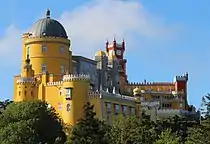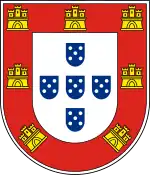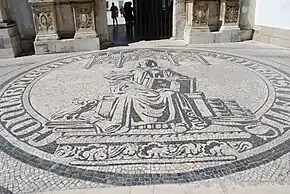
Portuguese pavement, known in Portuguese as calçada portuguesa or simply calçada is a traditional-style pavement used for many pedestrian areas in Portugal. It consists of small flat pieces of stones arranged in a pattern or image, like a mosaic. It can also be found in Olivença (a disputed territory administered by Spain) and throughout former Portuguese colonies. Portuguese workers are also hired for their skill in creating these pavements in places such as Gibraltar. Being usually used in sidewalks, it is in town squares and atriums that this art finds its deepest expression.
One of the most distinctive uses of this paving technique is the image of Saint-Queen Elizabeth of Portugal (Santa Rainha Isabel), in Coimbra, designed with black and white stones of basalt and limestone.
Origins
.jpg.webp)
- irregular pavements, thought to be the oldest style
- crushed pavement, similar but with more spaces between the stones
- classic style, with one primary diagonal and one secondary, both at 45 degrees to the adjoining kerb and/or wall.
- linear pavement, with stones aligned in parallel files
- circular pavement
- hexagonal pavement
- artistic pavement, with specific forms and/or highly contrasting stones
- large wavy pattern
- segmented fans
- florentine fans
- peacock tails
- less regular peacock tails
Paving as a craft is believed to have originated in Mesopotamia, where rocky materials were used in the inside and outside of constructions, being later brought to Ancient Greece and Ancient Rome.
The Romans used to pave the vias connecting the empire using materials to be found in the surroundings. Some of the Roman techniques introduced then are still applied on the calçada, most noticeably the use of a foundation and a surfacing.
Future
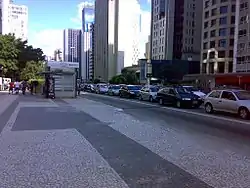
Very little new paving of this type is done, and the entire profession is at risk. The long hours and low wages typical of calceteiros have reduced apprenticeships and thus new pavers. Furthermore, as the pavement is less safe (provides less traction when wet; loose stones can become tripping hazards), costs more (especially with the difficulty of obtaining appropriate stones), and wears quicker than concrete or asphalt, there is also dropping interest in investment and construction in it. Although there were once hundreds of calceteiros, most modern work is on conservation or major architectural projects.
In spite of its historical and cultural value, this type of pavement has raised concerns in recent times, particularly in regards to its accessibility. Portuguese pavement has been noted for being particularly slippery, a condition worsened by natural wear and tear as well as by rainy conditions, the latter of which also allows for the formation of puddles in more concave, worn-out sections. Other disadvantages include the propensity for weeds and moss to form in its cracks.[2] The loosening of stones is also a relevant issue, making sidewalks covered by this type of pavement need constant maintenance and repair in order to avoid pedestrians from tripping. These qualities have often made transport for the elderly, wheelchair users, pregnant women and babies in strollers particularly difficult. Portuguese pavement is also especially harsh on some types of footwear.[3]
In Portugal, Porto completely replaced the traditional pavement of its city centre for granite blocks in 2005.[3]
In Brazil, while São Paulo has almost completely replaced the Portuguese pavement sidewalks of Paulista Avenue with a cheaper, more regular type of concrete pavement since 2007,[3] other cities such as Rio de Janeiro still have nearly ubiquitous Portuguese pavement, particularly in more affluent areas.
It can also be found around the Asunción Super Centro building in Asunción, Paraguay.[4]
Setting the stones
Craftsmen lay a bedding of gravel upon a well-compacted trench of argillaceous materials, which accommodates the tessera stones, acting as a cement.
 1. Preparation of stones
1. Preparation of stones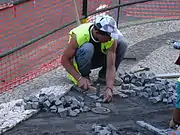 2. Manual placement
2. Manual placement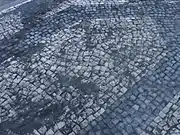 3. Cement mix spread on the pavement
3. Cement mix spread on the pavement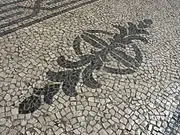 4. Final product
4. Final product
Calçada as a form of art
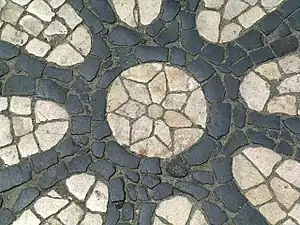 Stars in Lisbon
Stars in Lisbon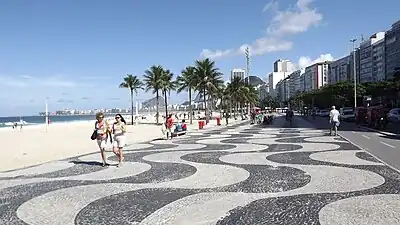 Portuguese pavement in Copacabana Beach, Rio de Janeiro
Portuguese pavement in Copacabana Beach, Rio de Janeiro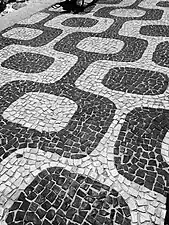 Pavement in Ipanema, Rio de Janeiro
Pavement in Ipanema, Rio de Janeiro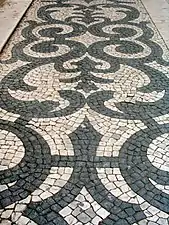 In Lisbon
In Lisbon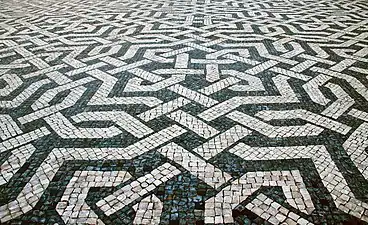 Restauradores Square, Lisbon
Restauradores Square, Lisbon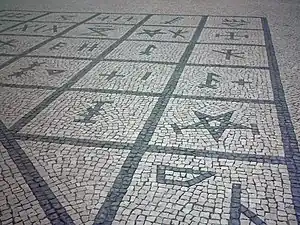 Póvoa de Varzim's runes in Praça do Almada
Póvoa de Varzim's runes in Praça do Almada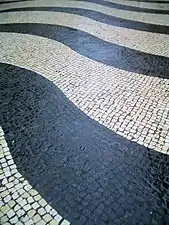 The Senado Square's distinctive tiled pattern in Macau
The Senado Square's distinctive tiled pattern in Macau.jpg.webp) Igreja de Nossa Senhora da Graça, Praia, Cape Verde
Igreja de Nossa Senhora da Graça, Praia, Cape Verde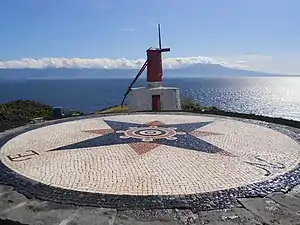 Compass rose depicted in São Jorge, Azores
Compass rose depicted in São Jorge, Azores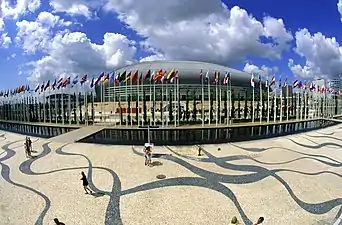
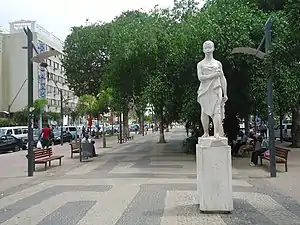

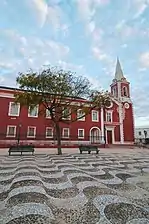
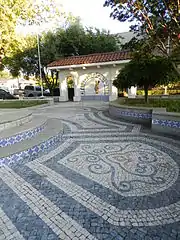 Portuguese Centennial Park, Hayward, United States
Portuguese Centennial Park, Hayward, United States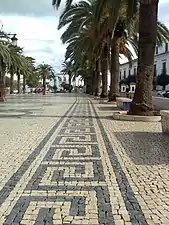 Plaza de España, Olivença
Plaza de España, Olivença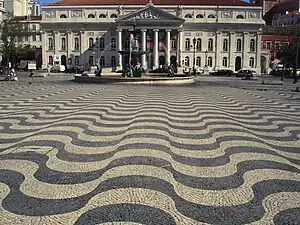 Pavement on the Rossio Square (Praça do Rossio), Lisbon
Pavement on the Rossio Square (Praça do Rossio), Lisbon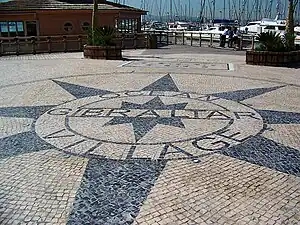 Pavement in Ocean Village Gibraltar
Pavement in Ocean Village Gibraltar.jpg.webp) Bom Jesus, Braga, Portugal
Bom Jesus, Braga, Portugal.jpg.webp)
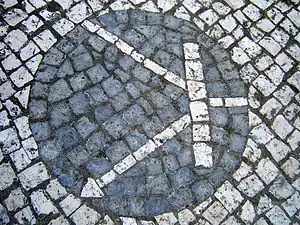 A transistor symbol at the University of Aveiro
A transistor symbol at the University of Aveiro.jpg.webp) A sidewalk in Portugal
A sidewalk in Portugal Portuguese pavement incorporating pavement lights
Portuguese pavement incorporating pavement lights
See also
References
- ↑ Prof. Ricardo Cunha Teixeira. Artigo no jornal Tribuna das Ilhas, "A matemática dos antigos". 20 September 2023.
- ↑ Medeiros Veiga, Marcia Regina (2020). Territórios de Cuidado: Protagonismo e pluralidade na velhice (in Portuguese). Coimbra: Coimbra University Press. p. 67-68. ISBN 9789892617978.
- 1 2 3 Cambiaghi, Silvana (December 2017). "Calçada em pedra portuguesa é adequada para utilização por todas as pessoas?". Móbile (in Portuguese). São Paulo: Revista CAU/SP. pp. 20–21. ISSN 2448-3885. Retrieved 2024-01-12.
- ↑ "Asunción Super Centro". Foursquare. Retrieved Dec 8, 2020.
External links
- Paving in Portuguese, urbanphoto.net
- Portuguese pavement and its histories (Portuguese language)
- The Portuguese Pavements Handbook (10 MB), Direccção Nacional de Energia e Geologia (Portuguese/English)
